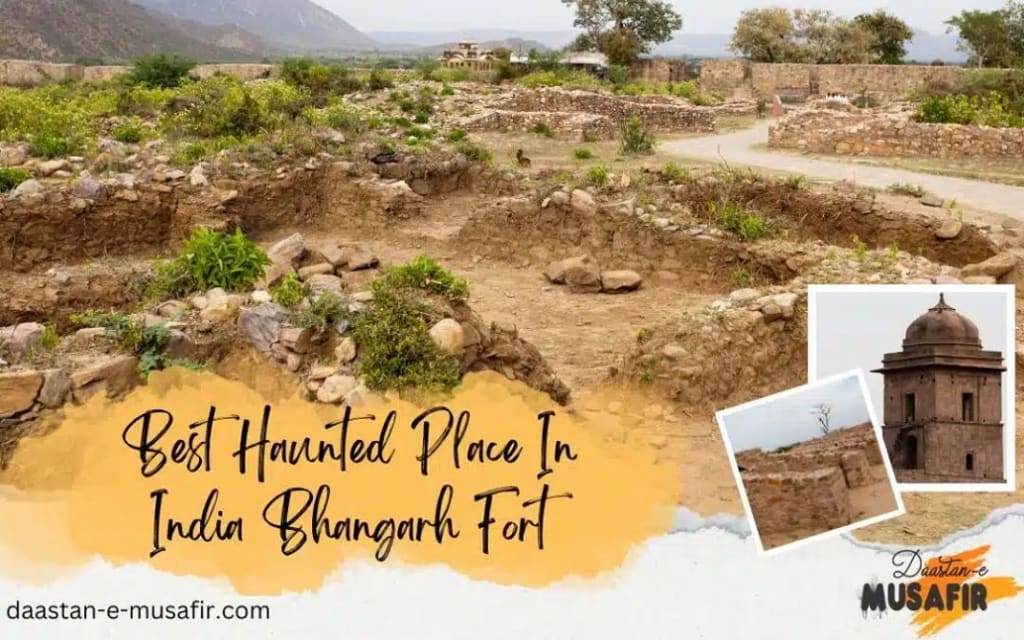Best Haunted Place In India Bhangarh Fort
Best Haunted Place In India Bhangarh Fort

Best Haunted Place In India Bhangarh Fort
Bhangarh Fort is indeed considered one of the most haunted places in India. Located in the Alwar district of Rajasthan, Bhangarh Fort is known for its eerie atmosphere and paranormal legends. Here's some information about Bhangarh Fort and why it is considered haunted:
Historical Background: Bhangarh Fort was built in the 17th century by Raja Bhagwant Das, a ruler of the Kachwaha Rajput dynasty. The fort complex includes temples, palaces, and several other structures. It was abandoned in the early 18th century.
The Curse: According to local legends, Bhangarh Fort became haunted due to a curse placed on it by a sorcerer. It is believed that the sorcerer fell in love with the princess of Bhangarh, and in an attempt to win her over, he used black magic on a cosmetic item. The princess discovered his plan and threw the item away, which hit the sorcerer and killed him. Before dying, he cursed the fort, saying that no one would be able to live within its walls.
Paranormal Experiences: Visitors and locals have reported experiencing strange occurrences at Bhangarh Fort. These experiences include hearing unexplained sounds, feeling a strong negative energy, witnessing apparitions, and experiencing an eerie feeling throughout the fort complex. Some people have claimed to have seen shadowy figures and heard disembodied voices.
Entry Restrictions: Due to the reported paranormal activities, the Archaeological Survey of India (ASI) has prohibited entry into Bhangarh Fort between sunset and sunrise. There are signboards put up by the ASI warning people about the potential dangers of entering the fort after dark.
Tourist Attraction: Despite its haunted reputation, Bhangarh Fort attracts a large number of tourists. People visit during the day to explore the architectural beauty of the fort and learn about its history. Many also visit with the hope of experiencing some paranormal activity.
It's important to note that while Bhangarh Fort has gained a reputation for being haunted, there is no scientific evidence to support the claims of paranormal activity. The legends and folklore surrounding the fort add to its mystique and allure, making it a fascinating destination for those interested in history, architecture, and the supernatural.
What is the real story of Bhangarh?
The real story of Bhangarh Fort involves historical events and legends that have contributed to its haunted reputation. While historical facts can be verified, the legends surrounding the fort are based on folklore and local beliefs. Here's a breakdown of the real story of Bhangarh:
Historical Background:
Bhangarh Fort was built in the 17th century by Raja Bhagwant Das, a ruler of the Kachwaha Rajput dynasty. The fort complex was constructed with several structures, including temples, palaces, and gateways. It was strategically located at the edge of the Sariska Tiger Reserve in present-day Alwar district, Rajasthan, India.
The Fort's Abandonment:
The decline of Bhangarh Fort is believed to have occurred in the early 18th century. It is widely speculated that the decline was due to the battles and conflicts between the Kachwaha rulers and the Marathas, which led to the fort's abandonment. Additionally, an earthquake in the region is said to have caused significant damage to the fort.
The Curse Legend:
The most popular legend associated with Bhangarh Fort is the curse placed upon it. According to folklore, a sorcerer named Singhia fell in love with Princess Ratnavati, who was a beautiful and intelligent ruler of Bhangarh. Seeking to win her affection, Singhia used black magic on a cosmetic item intended for the princess. However, Ratnavati discovered his plan and threw the item away, which struck Singhia and killed him. Before dying, Singhia cursed the fort, saying that no one would be able to live within its walls.
Paranormal Beliefs and Restrictions:
The curse legend and subsequent stories of paranormal experiences have contributed to the belief that Bhangarh Fort is haunted. Visitors and locals have reported hearing strange sounds, feeling negative energies, witnessing apparitions, and experiencing an eerie atmosphere within the fort complex. As a result, the Archaeological Survey of India (ASI) has prohibited entry into the fort between sunset and sunrise, and there are signboards warning people about the potential dangers of entering after dark.
While the historical background of Bhangarh Fort is supported by documented evidence, the curse legend and paranormal experiences associated with the fort are primarily based on local folklore and beliefs. The haunted reputation of Bhangarh Fort has made it a popular tourist destination, attracting people interested in its history, architecture, and supernatural elements.
Is Bhangarh Fort safe in night?
Bhangarh Fort is officially declared as off-limits during nighttime by the Archaeological Survey of India (ASI). Entry into the fort complex is prohibited between sunset and sunrise. The ASI has put up signboards warning visitors about the potential dangers of entering the fort after dark.
While the prohibition may be partly due to the fort's haunted reputation, there are other factors to consider as well. The fort is a historical site with uneven terrain, crumbling structures, and limited lighting, which can pose safety hazards at night. There is a risk of accidents, such as tripping, falling, or getting lost within the complex.
It's important to respect the rules and regulations set by the ASI for the safety and preservation of the site. If you plan to visit Bhangarh Fort, it is recommended to visit during the daytime when entry is permitted and take necessary precautions to ensure your safety.
Is Bhangarh Fort safe for kids?
Bhangarh Fort may not be considered entirely safe for kids, primarily due to its uneven terrain, crumbling structures, and lack of safety measures. Here are a few factors to consider:
Uneven Terrain: The fort complex consists of rough and uneven surfaces, including stairs, slopes, and rocky paths. Young children may find it challenging to navigate these areas, increasing the risk of tripping or falling.
Structural Condition: Some parts of the fort are in a state of disrepair, with crumbling walls and loose stones. There is a potential danger of structures collapsing or debris falling, especially if children try to climb or explore restricted areas.
Lack of Safety Measures: Bhangarh Fort does not have safety barriers, handrails, or protective measures in place to prevent accidents or falls. Parents and guardians need to be vigilant in ensuring their children's safety throughout the visit.
Remote Location: Bhangarh Fort is located in a somewhat isolated area, away from major towns or cities. The availability of immediate medical assistance or facilities in case of an emergency may be limited.
Considering these factors, it is advisable to exercise caution when visiting Bhangarh Fort with children. Parents or guardians should closely supervise their kids, keep them away from restricted areas, and ensure they are wearing appropriate footwear for walking on uneven surfaces. Additionally, it may be preferable to visit during daylight hours when visibility is better and the overall environment is safer.
Is Bhangarh a real place?
Yes, Bhangarh is a real place in India. Bhangarh is a historical site located in the Alwar district of Rajasthan, a state in northwest India. It is known for its famous Bhangarh Fort, which was built in the 17th century by Raja Bhagwant Das, a ruler of the Kachwaha Rajput dynasty.
Bhangarh Fort is an architectural marvel and attracts visitors from around the world who are interested in its history, ruins, and cultural significance. While it is known for its haunted reputation and legends, it is a real fort with tangible structures and a place of historical significance.
The fort complex includes various buildings, temples, gateways, and other structures, showcasing the architectural style of the period. The site is recognized by the Archaeological Survey of India (ASI) and is protected as a heritage site.
Bhangarh is not just known for its fort but also for its scenic surroundings, which include hills, forests, and the nearby Sariska Tiger Reserve. The combination of historical significance, folklore, and natural beauty has made Bhangarh a popular tourist destination in Rajasthan.
About the Creator
daastanemusafir
https://daastan-e-musafir.com/
Enjoyed the story? Support the Creator.
Subscribe for free to receive all their stories in your feed. You could also pledge your support or give them a one-off tip, letting them know you appreciate their work.






Comments
There are no comments for this story
Be the first to respond and start the conversation.